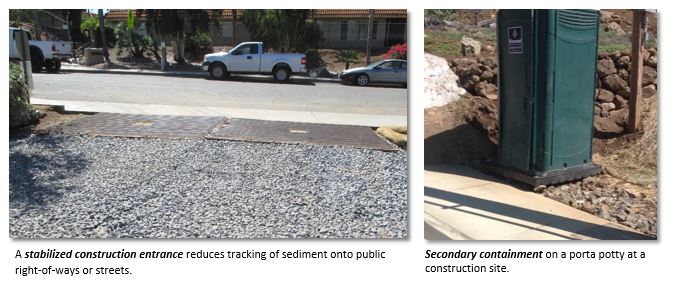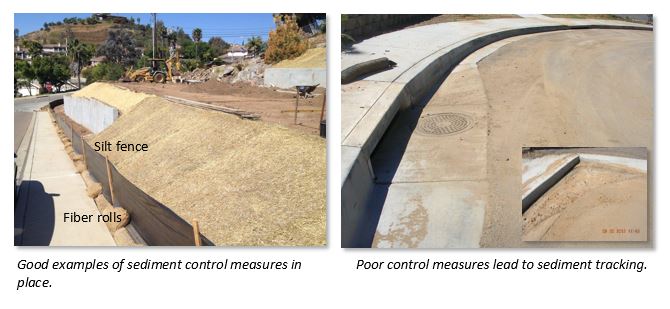Construction activities in Escondido are subject to pollution prevention measures due to the occurrence of erosion and sedimentation of bare soil grounds. Storm water runoff from construction sites, if not properly contained, carries materials such as sediment, concrete and trash which harm water quality and violate local and state storm water regulations. To prevent uncontrolled storm water runoff, construction sites are required to prepare an erosion control plan (ECP) incorporating storm water Best Management Practices (BMPs); for sites larger than one acre, a Storm Water Pollution Prevention Plan (SWPPP) is required per the Construction General Permit.
The ECP and/or SWPPP shows a mixture of erosion and sediment control BMPs tailored to the conditions of the project. The ECP is reviewed by the City of Escondido and SWPPP is reviewed and approved by the Regional Water Quality Control Board. City Field Engineering and Environmental Programs Inspectors will visit your site regularly to ensure BMPs are implemented in accordance with the grading permit, to reduce polluted runoff.
Best Management Practices at a Construction Site:
Erosion Control Measures
Practices to prevent soil particles and construction debris from entering storm water. Common practices include:
- Erosion control BMPs (bonded fiber matrix with hydroseed, blankets, plastic sheeting, etc) to cover areas vulnerable to erosion. Finished slopes should be stabilized within 14 calendar days of last being worked. All slopes need to be covered before a rainfall event.
- Stabilized entrances wherever vehicles enter unpaved areas (for example at the entrance to a project if none of it is paved, or onto individual lots on developments where streets have already been paved).
- Stockpiles need to be covered before forecast rain events or high wind and at the end of each working day.
- Good housekeeping:
- Portapotties need secondary containment.
- Waste materials should be stored in covered dumpsters.
- Trash and debris should not be stored on the ground.
- Solid materials should be stored off the ground and covered.
- Liquid materials should be stored under cover and in secondary containment.

Sediment Control Measures
Methods used to trap eroded sediment and prevent sediment from migrating off the site area. Common tools include:
- All slopes need to be protected.
- Perimeter control BMPs (silt fence, fiber roll, gravel bag berm etc.).
- Inlet protection: Gravel bags and filter fabric placed around an inlet to filter runoff and prevent sediment and debris from flowing into the storm drain.
- Silt fence: Installed to detain sediment laden water.
- Fiber rolls: Placed along site contours of a sloped area.

Discharging Impound Storm Water into a Storm Drain
Construction sites that plan to discharge impounded storm water into a storm drain must comply with the City’s Municipal Code Chapter 22. Construction projects enrolled in the State Construction General Permit (CGP) are allowed to discharge as long as permit and City requirements are followed, including discharge monitoring and pollutant reduction measures.
This form is only applicable to construction sites covered under the Construction General Permit (CGP) and will generate an email to the City of Escondido Field Engineering Division. Submissions will be reviewed within 2 business days. In addition to the Pre-discharge form a Post discharge form will also need to be submitted.
Pre-Discharge Form for Construction Sites (arcgis.com)
Post-Discharge Form for Construction Sites (arcgis.com)